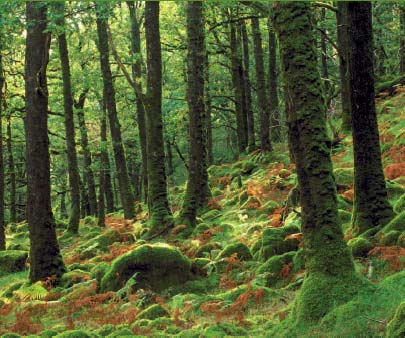Britain’s native trees have not always been present and rooted – they were scoured clean from the earth during the last ice age 20 000 years ago. Species migrated southwards until reaching the physical barrier of the Alps. As the ice retreated about 10 000 years later, trees recolonised the landscape. This was easier due to the land bridge connecting mainland Europe that was not yet covered by rising sea levels. After a few thousand years of growth, Britain would have been covered by magnificent woodland.

Ariundle Nature Reserve (scotland.gov.uk)
A few thousand years later, so about 5000 years ago, ancient peoples cleared small sections of forest for agriculture and livestock farming. These people had religions connected with nature and it is around this time (4000 to 5000 years ago), that Stonehenge was erected. Later, during the Iron Age, the Celtic priestly class or druids played a strong role in determining the inhabitants’ connection with nature and trees. It is thought the word ‘druid’ is derived from Indo-European roots meaning ‘oak-seer’ or ‘oak-knower’. Especially important trees in Celtic mythology and tradition were the oak, ash, apple, alder, elder and yew. Trees were sacred and had spirits, while forests were ruled by a single goddess.

Systems of thought connected to nature were more prevalent in ancient Britain (Wigulf)
The Romans brought more organized agriculture and farming, as well as increased deforestation. Roman expansion had already led to deforestation of the Mediterranean basin and resource pressure turned their eye towards Northern Europe and Britain. Naturally there were also political reasons for expansion, including punishment of the Britons for their aiding of the Gauls.
Deforestation continued and in 1086 William the Conqueror with his Domesday census found that less than 15 % of the natural forest remained across England. However, he did enact forest laws in order to sustain hunting grounds. During the middle ages Vikings also burned sections of forest as part of their campaigns.

The continuous demand for timber throughout history (ukscblog.com)
Deforestation continued with the industrial revolution and the rise of sheep farming, faster growing coniferous forests were planted and the ancient broadleaf forests continued their decline; this has been observed in the pollen record. After the First World War it was realised that Britain had nearly run out of timber, and further fast-growing species were introduced along with the creation of the Forestry Commission. Quick fixes often do not work in natural ecosystems, and this was too late for the wolf, bear, wild boar, beaver, lynx and elk.

Wolves were common in Britain (print by www.martinridley.com)
11.6 % of the U.K is currently covered by woodland, with England at about 9 % and Northern Ireland at 6.4 %. This is significantly lower than the European Union average of 37 %. While there are still pockets of ancient forests, trees in Britain have paid the price of industrialisation and war.
